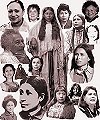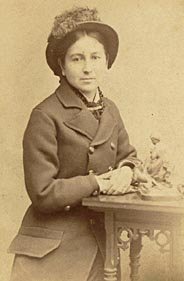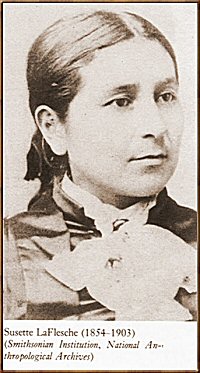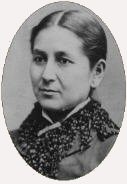 |
Ancient
Voices
A
Museum to honor the least known people in North America,
the Original Tribal Women |
Susette La Flesche Tibbles (1854-1903)

the unstrung bow was a symbol used by the La Flesche family

Inshata-Theumba, was the Indian name of Susette LaFlesche, who was first named Yosette, and was born in Bellevue in 1854, the year the Omaha gave up their Nebraska hunting grounds and agreed to move to a northeastern Nebraska reservation. She was the oldest daughter of Joseph LaFlesche, the last recognized chief of the Omaha and Mary, daughter of Fort Atkinson surgeon Dr. John Gale and Ni-co-ma of the Iowa tribe. Joseph was known as "Iron Eyes." Susette was raised on the Omaha reservation and from 1862 to 1869 attended the Presbyterian Mission Boarding Day School on the reservation. The Mission School had been started at Bellevue in 1845 and was moved to the reservation in 1857. Susette learned to read, write, and speak English and to cook and sew.
Iron Eye's belief that his people's future lay in becoming educated, in using the farming methods of the white man, in becoming Christians, and in adopting the white man's ways greatly influenced Susette and her brothers and sisters. Although Susette and her siblings disagreed about political issues and economic methods which affected the Omaha, all of them contributed to the improvement in life of native Americans and particularly the Omaha tribe.
After Susette expressed her desire to further her education, arrangements were made in 1869 for her to attend the Elizabeth Institute for Young Ladies, a private school at Elizabeth, New Jersey. She became known for her writing ability, and an essay written during her senior year, was published by the New York Tribune. Following her graduation, Susette returned to the reservation. Three years later, Susette was accepted as a teacher at the government school on the reservation and she taught there for several years.

In 1877, the Ponca tribe was dislocated to Indian Territory. Iron Eye's mother was Ponca, and so he went to Indian Territory to investigate conditions under which the Ponca were living. Susette went along. When they returned, Susette worked with Thomas H. Tibbles of the Omaha Herald to publicize the Ponca's plight.
A few Ponca led by Standing Bear had returned to Nebraska. Standing Bear's subsequent arrest and trial in Omaha. Susette was the interpreter for Standing Bear during his trial at Fort Omaha in May 1879. It was there that Standing Bear successfully argued before Judge Elmer Dundy's of the United States District Court that an Indian was a person in the eyes of the law, and had all the rights of U.S. citizens.
After the trial, Susette became known as "Bright Eyes." Tibbles organized a speaking tour of the eastern United States for Standing Bear, Bright Eyes, and her brother, Francis LaFlesche. They were entertained by Henry Wadsworth Longfellow at his home at Cambridge, Massachusetts. When he saw Bright Eyes, Longfellow said, "This could be Minnehaha," the Indian maiden in his poem "The Song of Hiawatha."
Along with Tibbles, Bright Eyes appeared before a congressional committee, presenting her concerns about native American rights.

In 1882 Bright Eyes and Thomas Tibbles were married. They continued their lecture tours in the East, and during 1886 traveled to England and Scotland for a ten-month tour. Here Bright Eyes was received by nobility and by literary circles. When they returned to Omaha in 1890, Tibbles went back to work at the Omaha World-Herald.
In 1891 they traveled to Pine Ridge in southwestern South Dakota to inquire about the Battle of Wounded Knee and problems of native Americans at the reservation there. From 1893-1895 the Tibbles lived in Washington D.C. where he worked as a newspaper correspondent.
With Fannie Reed Griffin, Bright Eyes co-authored a book, Oo-mah-ha Ta-wa-tha in 1898,and illustrated it. Her art work appeared in several books, among them Ploughed-Under:The Story of an Indian Chief, which she also edited.
Bright Eyes continued to write, lecture, and to advocate Indian concerns before government committees. Thomas Tibbles and Bright Eyes moved to Bancroft in 1902 to live among the Omaha. She died there on May 26, 1903 at her home near Bancroft at the age of 49.
She was eulogized in the U.S. Senate and is remembered as the first woman to speak out for the cause of native Americans.

Susette ("Bright Eyes") LaFlesche Tibbles was inducted into the Nebraska Hall of Fame in 1983.
Bright Eyes was the sister of the physician Dr. Susan LaFlesche Picotte and of Smithsonian ethnologist Francis LaFlesche who are particularly noteworthy in their own right

La Flesche Family
Standing Susan, sitting right Susette, left Francis
Read the Books about Susette La Flesche and her family
 |
Susette La Flesche
by Marion Marsh Brown
CHILDRENS PRESS, 1992, ISBN: 0516032771 |
 |
Iron Eye's Family:
The Children of Joseph La Flesche
by Norma Kidd Green |
See more books on Susan La Flesche's page |









